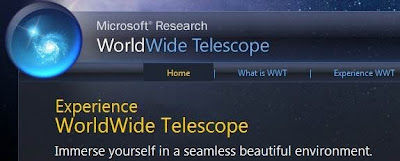This is an awesome program from Microsoft Research. Below you will find a item from makeuseof.com describing what they call one of the 5 best MS products. It comes as an installed client program for Windows users but they also offer a browser version for MAC or Windows use. If you don't want to install it you can download the web client.
WorldWide Telescope minimum system requirements (For PC):
* Microsoft® XP SP2 (minimum), Windows® Vista® (recommended)
* PC with Intel Core 2 Duo processor with 2 gigahertz (GHz) or faster, recommended
* 1 gigabyte (GB) of RAM; 2 GB RAM recommended
* 3D accelerated card with 128 megabytes (MB) RAM; discrete graphics card with dedicated 256-MB VRAM recommended for higher performance
* 1 GB of available hard disk space; 10 GB recommended for off-line features and higher performance browsing
* XGA (1024 x 768) or higher resolution monitor
* Microsoft Mouse or compatible pointing and scrolling device
* Microsoft® DirectX® version 9.0c and .NET Framework 2.0
* Required for some features; Internet connection at 56 Kbps or higher.
I use it on a P4 3.0 GHz, with 4 GB RAM with 512 MB PCI-Express Video with hi-speed extreme thru a cable provider.
Big file for dialup users.
Click below to read about it and you can download it there:
http://www.worldwidetelescope.org/
#3: World Wide Telescope
Microsoft WorldWide Telescope (WWT) brings terabytes of imagery from the best ground telescopes and the Hubble Space Telescope to your desktop. It seamlessly combines the data from these multiple sources into a rich immersive world that you can explore from your home. Use the native Windows client for all features, or the web client for a smaller subset. Guided tours from experts are a great way to introduce the stars and galaxies to youngsters. Exploration is possible not only in the visible light spectrum, but also in non-visible wavelengths such as x-ray and infrared.
The user interface and imagery use Photosynth technology and is said to be significantly better than Google Sky.
*Thanks, Gary

No comments:
Post a Comment